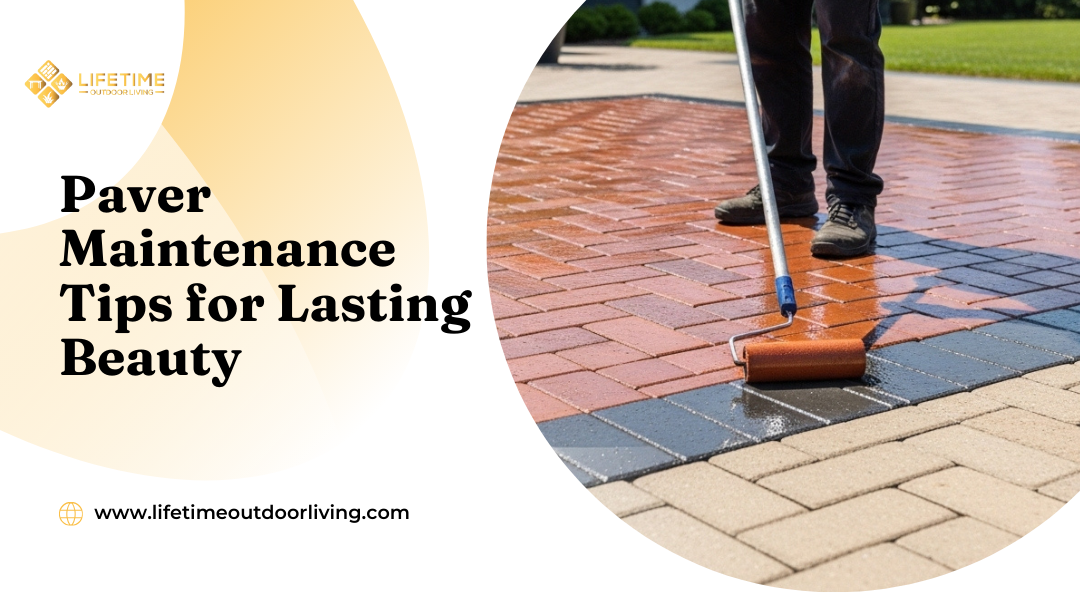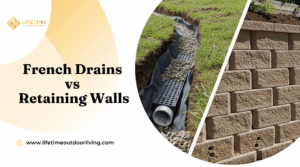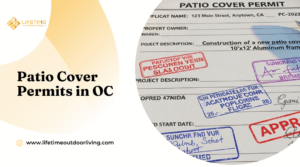Pavers can transform any outdoor space into a stunning focal point, but their beauty depends entirely on proper maintenance. Without regular care, even the highest-quality pavers can lose their luster, develop stains, and allow weeds to take hold between joints.
Regular maintenance practices like routine cleaning, stain prevention, and proper sealing can keep pavers looking as good as the day they were installed. The key lies in understanding which techniques work best and when to apply them. Professional maintenance goes beyond basic cleaning to address issues like joint sand replenishment, weed prevention, and protective sealing.
Laguna Beach’s coastal climate presents unique challenges for paver maintenance, from salt air exposure to seasonal weather changes. This comprehensive guide covers everything from daily care routines to seasonal maintenance strategies, helping homeowners protect their investment and maintain beautiful outdoor spaces year-round.
Why Paver Maintenance Is Essential
Regular paver maintenance protects the substantial financial investment homeowners make in their outdoor spaces while preventing costly structural damage. Proper care prevents permanent stains and surface deterioration that can compromise both functionality and visual appeal.
Protecting Your Investment
Pavers represent a significant financial commitment that can cost thousands of dollars for installation. Without proper maintenance, this investment deteriorates rapidly through weather exposure and daily wear.
Sealed pavers last 2-3 times longer than untreated surfaces. The protective barrier prevents water penetration that leads to freeze-thaw damage during winter months.
Regular maintenance prevents the need for complete replacement projects. Minor repairs and cleaning cost hundreds of dollars compared to thousands for full reinstallation.
Property owners who neglect paver care often face these expensive issues:
- Joint sand erosion requiring complete re-sanding
- Structural settling from water damage
- Individual paver replacement due to cracking
- Weed growth that displaces pavers
Professional maintenance contracts typically cost $200-400 annually. This minimal expense protects investments worth $5,000-15,000 for typical residential installations.
Preventing Stains, Cracks, and Wear
Unsealed pavers absorb oils, food spills, and organic matter within hours of contact. These substances penetrate deep into the porous surface, creating permanent discoloration that cannot be removed through standard cleaning.
Oil stains from vehicles are particularly problematic on driveways. Once absorbed, they spread beneath the surface and darken surrounding areas.
Seasonal maintenance prevents crack formation from temperature fluctuations. Pavers expand and contract with weather changes, creating stress points that develop into visible damage over time.
Key prevention strategies include:
- Immediate spill cleanup within 30 minutes
- Annual sealing applications
- Regular joint sand inspection
- Prompt weed removal before root systems develop
Surface wear patterns develop in high-traffic areas without protective treatments. Foot traffic and furniture placement create permanent impressions that compromise the level surface.
Enhancing Curb Appeal and Home Value
Well-maintained pavers significantly impact property value and visual appeal. Real estate professionals report that quality hardscaping adds 10-15% to home values in competitive markets.
Clean, sealed pavers maintain their original color intensity for decades. Untreated surfaces fade to dull gray tones within 2-3 years of installation.
Regular maintenance prevents the “neglected property” appearance that affects neighborhood aesthetics. Weed-filled joints and stained surfaces create negative first impressions for visitors and potential buyers.
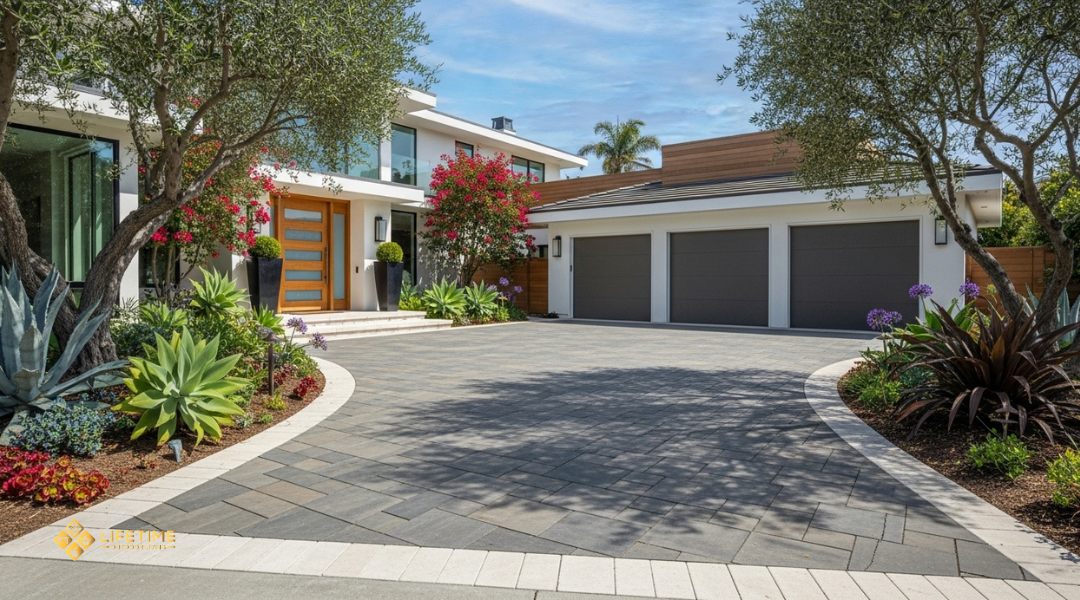
Professional maintenance ensures consistent appearance across entire installations. DIY cleaning often creates uneven results with visible cleaning lines and inconsistent color restoration.
Maintained pavers complement landscaping investments by providing clean borders and defined spaces. Deteriorated hardscaping detracts from expensive plantings and outdoor features.
Property listings featuring well-maintained outdoor spaces receive 25% more showing requests according to real estate data. This increased interest translates directly into faster sales and higher offers.
Routine Cleaning Practices for Pavers
Regular maintenance prevents stains from setting and preserves the natural beauty of paving stones. Simple weekly cleaning combined with monthly deep cleaning keeps pavers looking fresh without requiring expensive restoration services.
How Often Should You Clean Pavers
Weekly cleaning removes surface debris and prevents organic matter from staining the stones. A quick sweep or rinse prevents leaves, dirt, and food spills from penetrating paver surfaces.
Monthly deep cleaning addresses embedded dirt and minor stains. This frequency prevents the buildup of grime that becomes difficult to remove over time.
Seasonal maintenance should occur four times per year. Spring cleaning removes winter debris, summer maintenance handles pool chemicals and barbecue stains, fall cleaning clears leaves and organic matter, and winter preparation protects against freeze damage.
High-traffic areas like driveways and main walkways need attention twice weekly. Pool decks require cleaning after each use during swimming season due to chlorine and sunscreen exposure.
Best Tools and Products to Use
Essential cleaning tools include a stiff-bristled broom, garden hose with adjustable nozzle, and scrub brush for stubborn spots. Pressure washers work effectively but require careful technique to avoid damaging joints.
| Tool Type | Best Use | Frequency |
|---|---|---|
| Push broom | Daily debris removal | Weekly |
| Garden hose | General rinsing | Weekly |
| Scrub brush | Spot cleaning | As needed |
| Pressure washer | Deep cleaning | Monthly |
Recommended cleaning products include mild dish soap mixed with warm water for general cleaning. Specialized paver cleaners handle oil stains and efflorescence without damaging the stone surface.
Avoid bleach, acid-based cleaners, and de-icing salts. These chemicals can discolor pavers and weaken joint sand.
Safe Techniques for Removing Dirt and Debris
Start with dry removal by sweeping loose debris before applying water. This prevents mud formation and makes wet cleaning more effective.
Use the two-bucket method for soap cleaning. Fill one bucket with soapy water and another with clean rinse water to avoid spreading dirt across clean areas.
Work in small sections of 4-6 square feet. Apply cleaning solution, scrub gently in circular motions, then rinse immediately to prevent soap residue.
Pressure washing requires proper technique. Hold the wand 12-18 inches from the surface and use a 25-degree nozzle. Move in steady, overlapping passes to ensure even cleaning.
Address stains immediately when possible. Blot liquid spills rather than wiping to prevent spreading. Apply appropriate cleaners and allow dwell time before scrubbing.
Dealing With Stains and Spills
Quick action prevents most stains from becoming permanent damage on pavers. Different stain types require specific cleaning methods and products to restore the original appearance without damaging the paver surface or protective sealers.
Oil and Grease Stain Removal
Fresh oil spills should be addressed immediately by absorbing excess liquid with paper towels or absorbent materials. Avoid spreading the oil by pressing straight down rather than wiping across the surface.
For fresh oil stains:
- Sprinkle baking soda, cat litter, or cornstarch over the spill
- Allow the absorbent material to sit for 30 minutes
- Sweep up the material and dispose of it properly
For set-in oil stains:
- Apply dish soap directly to the stain
- Scrub with a stiff brush in circular motions
- Rinse thoroughly with hot water
- Repeat if necessary
Commercial degreasing products designed for concrete and pavers provide stronger cleaning power for stubborn petroleum stains. These products typically require 10-15 minutes of contact time before scrubbing and rinsing.
Food, Drink, and Organic Stains (Leaves, Mold, Algae)
Organic stains respond well to mild cleaning solutions and regular maintenance. Most food and beverage spills clean easily when addressed promptly with soap and water.
For organic stains:
- Mix 1 part white vinegar with 3 parts warm water
- Apply the solution and let it sit for 5-10 minutes
- Scrub gently with a soft brush
- Rinse completely with clean water
Mold and algae growth typically occurs in shaded, moist areas between pavers. A diluted bleach solution (1 part bleach to 10 parts water) effectively kills these organisms.
Leaf stains and tannins require prompt removal to prevent permanent discoloration. Sweep leaves regularly and use a pressure washer on low settings to remove stubborn organic residue from paver surfaces.
Rust and Hard Water Marks
Rust stains appear orange or reddish-brown and typically originate from metal furniture, tools, or irrigation systems. Hard water deposits create white, chalky buildup on paver surfaces.
Rust removal process:
- Apply lemon juice or white vinegar directly to rust spots
- Allow 15-20 minutes of contact time
- Scrub with a plastic brush to avoid scratching
- Rinse thoroughly and repeat if needed
Commercial rust removers containing oxalic acid provide stronger cleaning action for severe rust stains. Always test these products on an inconspicuous area first.
Hard water mark removal:
- Create a paste using baking soda and water
- Apply to affected areas and scrub gently
- Rinse with distilled water to prevent new mineral deposits
Regular sealing helps prevent both rust and hard water stains from penetrating deeply into paver surfaces.
Preventing Weeds, Moss, and Shifting
Proper maintenance focuses on three critical areas that can compromise paver appearance and stability. Joint sand replacement, targeted weed prevention, and prompt repair of settling issues keep installations looking professional for years.
Importance of Joint Sand (Polymeric Sand)
Polymeric sand creates a binding barrier between pavers that prevents most maintenance issues. This specialized sand contains polymers that activate with water to form a semi-flexible joint.
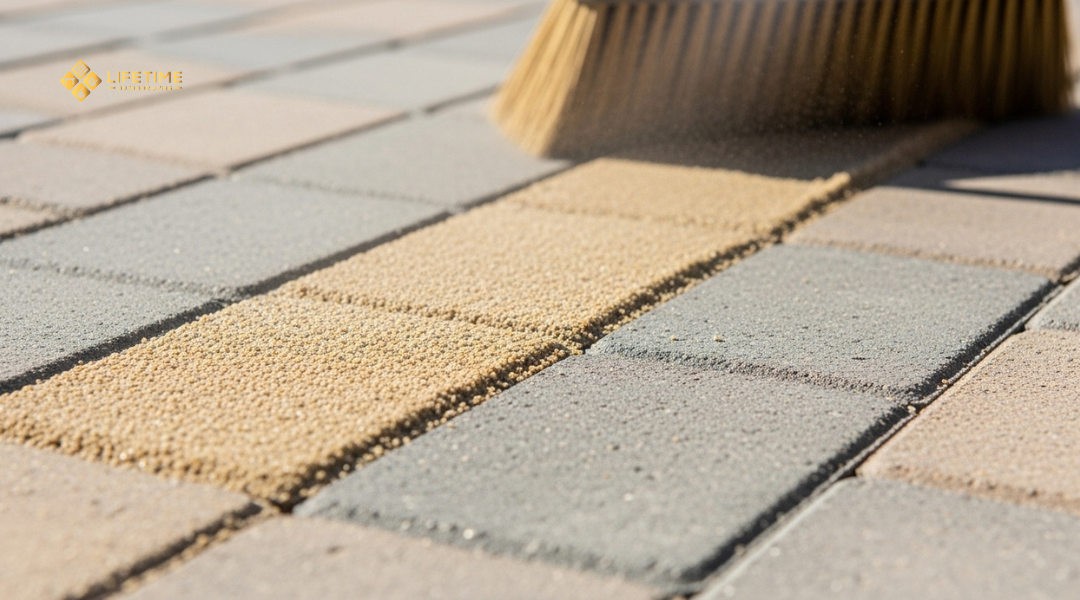
The sand locks pavers in place and blocks weed seeds from taking root. It also prevents ants and other insects from creating tunnels beneath the surface.
Application requires specific conditions:
- Surface must be completely dry
- Temperature between 32°F and 85°F
- No rain expected for 24 hours
Property owners should reapply polymeric sand every 2-3 years or when joints appear empty. Worn joints allow movement and create spaces for unwanted growth.
Traditional sand washes away with rain and irrigation. Polymeric sand stays in place and maintains its protective barrier longer.
Weed Control Strategies
Pre-emergent herbicides applied in early spring prevent weed seeds from germinating in paver joints. These treatments work best before weeds appear.
Timing matters for maximum effectiveness. Apply treatments in March before soil temperatures reach 55°F consistently.
Manual removal works for established weeds but requires complete root extraction. Pull weeds when soil is moist for easier removal.
Pressure washing removes surface weeds but can damage joint sand. Use low pressure settings and avoid directing water directly into joints.
Natural alternatives include:
- White vinegar (20% acetic acid)
- Boiling water for small areas
- Corn gluten meal as pre-emergent
Regular sweeping prevents organic debris from accumulating in joints. Leaves and dirt create growing medium for weed seeds.
Addressing Uneven or Sunken Pavers
Settlement occurs when base materials compact or wash away beneath pavers. Traffic loads and water infiltration accelerate this process.
Early warning signs include:
- Pavers rocking when stepped on
- Visible gaps between units
- Standing water in low spots
- Cracked or chipped edges
Individual pavers can be lifted and releveled without disturbing surrounding areas. Remove the affected paver and add base material as needed.
Extensive settling requires professional assessment of drainage and base preparation. Poor initial installation often causes widespread movement.
Prevention measures include:
- Proper drainage away from paved areas
- Regular joint sand maintenance
- Avoiding heavy vehicle traffic on residential installations
Address minor settling immediately to prevent larger problems. Small adjustments cost less than major reconstruction projects.
Sealing Your Pavers for Long-Lasting Protection
Paver sealing acts as a protective barrier that enhances color vibrancy while defending against stains, weather damage, and surface deterioration. The coastal California environment requires specific sealing schedules and techniques to combat salt air and moisture exposure effectively.
Benefits of Paver Sealant (Color, Durability, Stain Resistance)
Color Enhancement and Protection
Paver sealers restore faded surfaces and intensify natural stone colors. Sealed pavers maintain their original appearance longer by blocking UV rays that cause color degradation over time.
Surface Durability
The protective coating prevents surface erosion and reduces wear from foot traffic. Sealed pavers resist cracking and chipping better than untreated surfaces, extending their functional lifespan.
Stain and Water Resistance
Sealers create a barrier against oil spills, food stains, and organic matter. This protection makes cleaning easier and prevents permanent discoloration from common patio spills.
Joint Sand Stabilization
Quality sealers prevent sand migration between paver joints. This stabilization reduces weed growth and maintains the structural integrity of the paver installation.
How Often to Reseal in Coastal California Climate
Standard Resealing Schedule
Most concrete pavers require resealing every 2-3 years in coastal environments. Natural stone pavers may need attention every 3-4 years depending on their porosity and traffic exposure.
Climate-Specific Factors
Salt air accelerates sealer breakdown along the California coast. Ocean moisture and marine fog create conditions that require more frequent maintenance than inland locations.
Signs Requiring Immediate Attention
- Water absorption instead of beading on the surface
- Visible color fading or dullness
- Increased staining from spills
- Sand loss between joints
Property owners should inspect their pavers twice yearly to assess sealer condition and plan maintenance timing accordingly.
Professional vs. DIY Sealing
Professional Application Advantages
Contractors use commercial-grade equipment for even coverage and proper surface preparation. They understand local climate challenges and select appropriate sealer types for specific paver materials.
Professional teams complete projects faster with consistent results. They also provide warranties on both materials and workmanship.
DIY Considerations
Homeowners can purchase retail sealers and basic application tools. However, improper surface preparation or uneven application creates streaking and premature failure.
Cost Comparison
| Approach | Initial Cost | Long-term Value |
|---|---|---|
| Professional | Higher upfront | Better durability, warranty coverage |
| DIY | Lower materials cost | Potential reapplication needs |
Climate expertise and proper equipment access often make professional sealing the more cost-effective choice for coastal California properties.
Seasonal Maintenance Tips in Laguna Beach’s Climate
Laguna Beach’s coastal Mediterranean climate presents unique challenges for paver maintenance, from intense summer UV exposure to winter moisture and year-round salt air exposure. Property owners must adapt their maintenance routines to address these specific environmental factors.
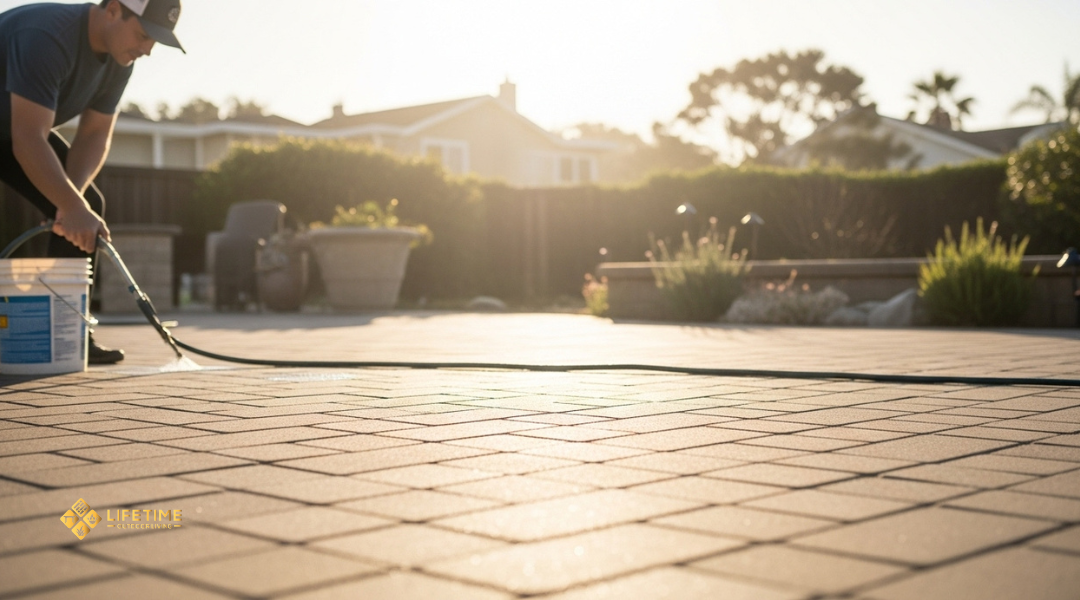
Summer Sun & UV Protection
The intense California sun can cause significant damage to pavers during Laguna Beach’s dry summer months. UV rays fade colored pavers and break down protective sealants more rapidly than in other climates.
Sealing Schedule Adjustments
- Apply UV-resistant sealers every 2-3 years instead of the typical 3-5 year cycle
- Schedule sealing during cooler morning hours between 6-9 AM
- Choose sealers with UV inhibitors specifically designed for coastal applications
Heat Management Strategies
Regular cleaning becomes crucial during summer months. Debris and organic matter can create hot spots that damage individual pavers.
Weekly hosing removes surface dust and prevents heat buildup. Light-colored pavers reflect more heat but show stains easily, requiring more frequent attention.
Protective Measures
- Install shade structures over high-traffic paver areas
- Use breathable sealers that won’t trap moisture beneath the surface
- Monitor for thermal expansion gaps between pavers
Rainy Season Drainage & Mold Prevention
Laguna Beach’s winter rainy season typically runs from December through March, creating moisture-related challenges for paver installations. Poor drainage can lead to standing water, mold growth, and structural issues.
Drainage System Maintenance
Clean drainage channels and gaps between pavers before the rainy season begins. Remove accumulated sand and debris that blocks water flow.
Check that water flows away from structures and doesn’t pool on paver surfaces. Install or maintain proper slope gradients of at least 1/4 inch per foot.
Mold and Algae Prevention
- Apply anti-fungal treatments in October before rains begin
- Increase cleaning frequency during wet months
- Use pressure washing with appropriate PSI settings (1500-2000 PSI maximum)
- Address shaded areas where moisture lingers longer
Winter Inspection Tasks
Inspect joint sand levels monthly during rainy season. Heavy rains can wash away polymeric sand between pavers, creating instability.
Ocean Air and Salt Exposure Considerations
Laguna Beach’s proximity to the Pacific Ocean means pavers face constant salt air exposure, accelerating deterioration and requiring specialized maintenance approaches.
Salt Damage Prevention
Salt crystals penetrate paver surfaces and cause spalling when they expand and contract. Regular rinsing removes salt buildup before it penetrates deeply.
Rinse pavers weekly with fresh water, especially after windy days when salt spray travels further inland. Focus on windward-facing surfaces that receive direct ocean exposure.
Product Selection for Coastal Conditions
- Use marine-grade sealers designed for salt exposure
- Choose non-slip additives for areas that become slippery when wet
- Select joint sand products with salt-resistant polymers
Maintenance Frequency Adjustments
Properties within 1/2 mile of the ocean require more frequent maintenance cycles. Salt accelerates the breakdown of protective coatings and cleaning products.
Monthly Salt Removal Protocol
- Rinse with fresh water using garden hose
- Apply mild detergent solution if salt residue remains
- Rinse thoroughly to remove all cleaning products
- Allow complete drying before applying any treatments
When to Call a Professional Paving Contractor
Certain paver issues require professional expertise beyond basic maintenance. Complex structural problems, extensive damage, and warranty considerations often necessitate hiring experienced contractors.
Signs Your Pavers Need Expert Repair or Replacement
Structural settlement indicates serious foundation issues that homeowners cannot address safely. When multiple pavers sink or create uneven surfaces, the problem typically stems from improper base preparation or soil movement.
Widespread cracking across numerous pavers signals underlying structural problems. Individual cracked pavers can be replaced by homeowners, but extensive cracking requires professional assessment.
Drainage problems manifest as standing water or erosion around paved areas. These issues often require:
- Grade adjustments
- Base layer reconstruction
- Installation of proper drainage systems
Edge restraint failure causes pavers to spread apart or shift significantly. This structural component requires specific tools and expertise to repair correctly.
Sand joint deterioration affecting large areas becomes labor-intensive for homeowners. Professionals can efficiently remove old sand, clean joints, and install new polymeric sand.
Advantages of Hiring Lifetime Outdoor Living
Local expertise in Laguna Beach conditions gives Lifetime Outdoor Living unique advantages. They understand coastal weather patterns, soil types, and municipal requirements specific to the area.
Professional equipment allows for efficient completion of large projects. Plate compactors, diamond blade saws, and specialized lifting tools ensure proper installation and repairs.
Quality materials sourced through contractor networks often exceed retail options. Professional-grade sealers, polymeric sands, and replacement pavers provide superior longevity.
Warranty protection covers both materials and workmanship. This protection provides peace of mind for significant investments in outdoor living spaces.
Time efficiency matters for extensive projects. Professional crews complete complex repairs in days rather than weeks of weekend work.
Warranty and Long-Term Support
Comprehensive warranties typically cover structural issues for multiple years. Lifetime Outdoor Living provides specific warranty terms for different types of work performed.
Ongoing maintenance programs help preserve warranty coverage. Regular professional inspections identify problems before they become costly repairs.
Material warranties from manufacturers often require professional installation. DIY repairs may void these important protections on premium paving products.
Emergency services become available for urgent issues like significant settling or safety hazards. Professional contractors can respond quickly to prevent further damage or liability concerns.

